Publisher Button Shy has made their mark on the hobby with their wallet games consisting of simply a deck of cards, usually 18 cards to be exact.
Sprawlopolis, a game in which players assume the role of city planners, is one of their most popular. Continue reading our Sprawlopolis review to learn more about this puzzley card game.
Contents
Sprawlopolis Overview
Sprawlopolis is a small, cooperative card game that plays 1 to 4 players who act as city planners, trying to build up the city and best meet the game’s 3 objectives.
Together, these objectives determine your scoring conditions and the target score for your game. If players meet or exceed the target score, they all win!
Sprawlopolis Cards
Sprawlopolis consists of 18 double-sided cards with a Block side and a Scoring Condition side.
The Block side of a card is divided into 4 blocks. Each block features 1 of the game’s zone types: park (green), commercial (blue), residential (orange), and industrial (grey). Every card will always have 1 of each of these zones on it.
Additionally, there are 1 or 2 roads in various configurations passing through different zones on the Block side of the cards.
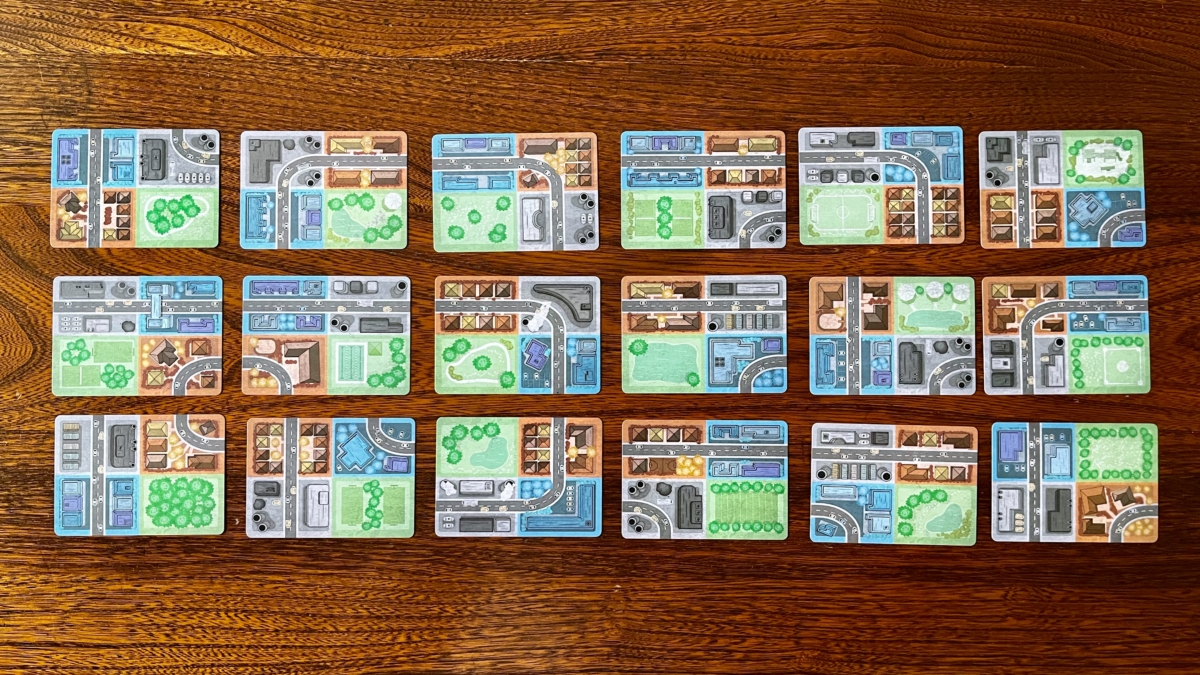
Here are the Block sides of the game’s cards.
On the other side of a card is a unique Scoring Condition. This side of the card lays out additional conditions for players to work toward scoring points.
Each Condition also has its own value that is used to calculate the target score for the game.
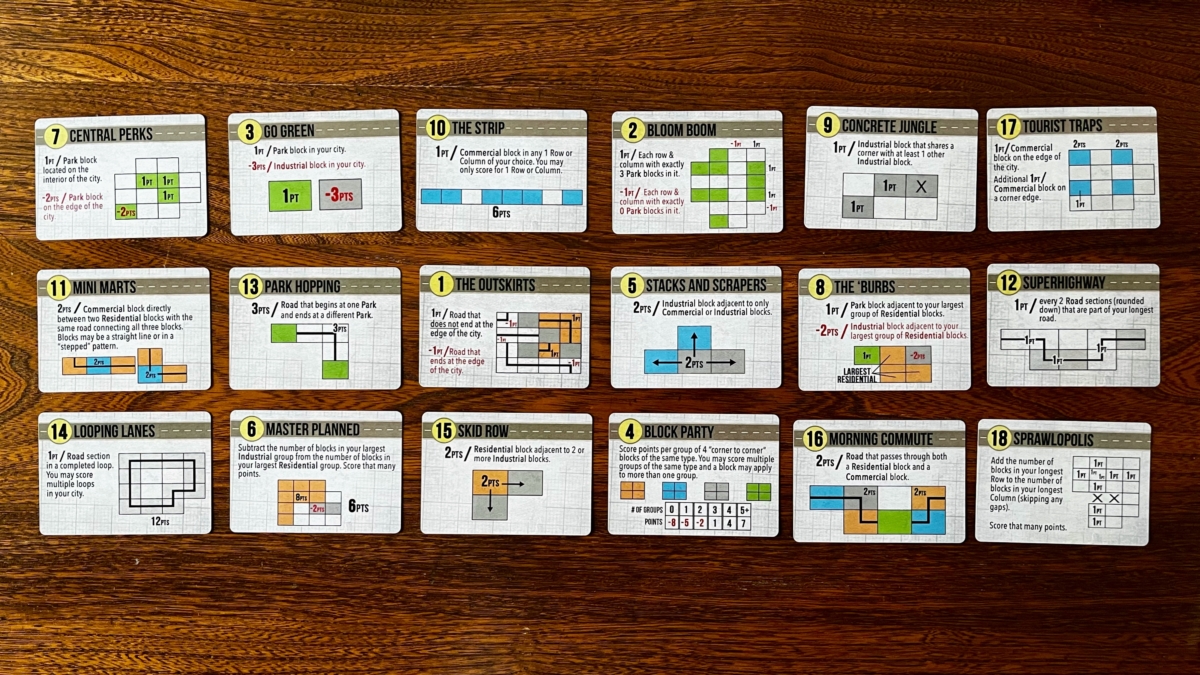
These are the Scoring Conditions in Sprawlopolis.
In each game, only 3 Scoring Conditions are used; the remaining 15 cards are used for their Block side only.
The numbers in the upper left corner of these 3 Scoring cards are added together and the total sum is the players’ target score for the game.
How To Play Sprawlopolis
While Sprawlopolis is technically a multiplayer cooperative game, it shines as a solo experience.
I’ll explain the solo rules here but will detail how the game changes with more players later in the review.
Solo
Setup
To begin, shuffle the deck of cards and draw 3 randomly, placing them with their Scoring Condition side face up.
These are your 3 objectives for the game and their numbers are used to determine your target score.
The remaining cards form a draw deck with their Block side face up. Draw 3 cards from this deck into your hand.
Then, place the top card from the deck in the “build area” to begin your city. (You’ll add other Block cards to this area throughout the game.)
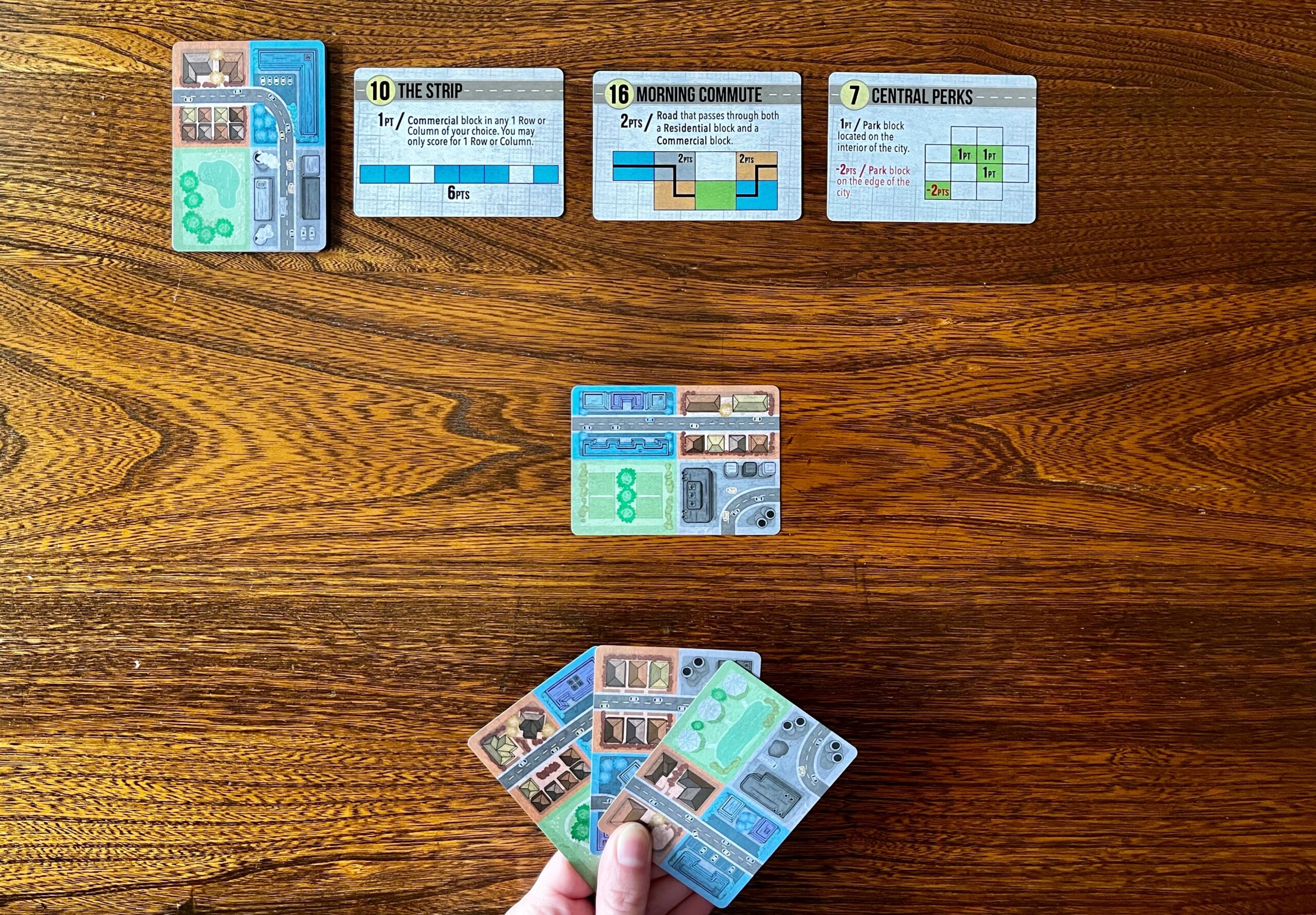
A game of Sprawlopolis set up. The target score for this game is 33 (10+16+7).
Player Turn
On your turn, you’ll choose 1 Block card in your hand to play. There are some placement rules to follow when adding a card to your city’s build area:
- You must place a card so that at least 1 block edge touches the edge of an already-played card, or
- You must cover at least 1 block on an already-played card in your build
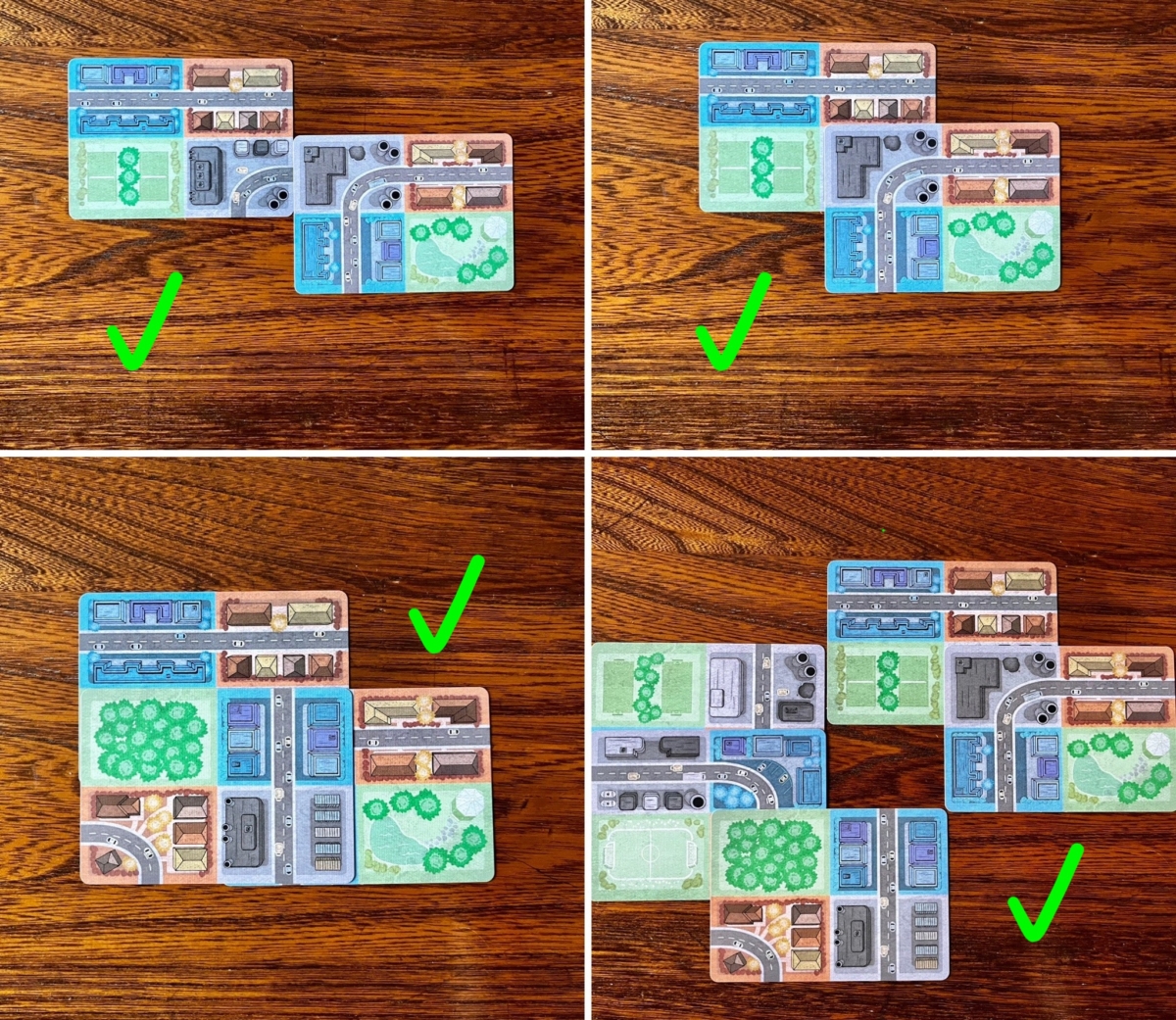
Here are 4 examples of legal card placements.
You are never allowed to:
- Tuck a card underneath another card in your city.
- Add a card to your city by only connecting at the corner and not by an edge.
- Play cards vertically. (You are, however, allowed to rotate cards 180 degrees as long as they’re played horizontally).
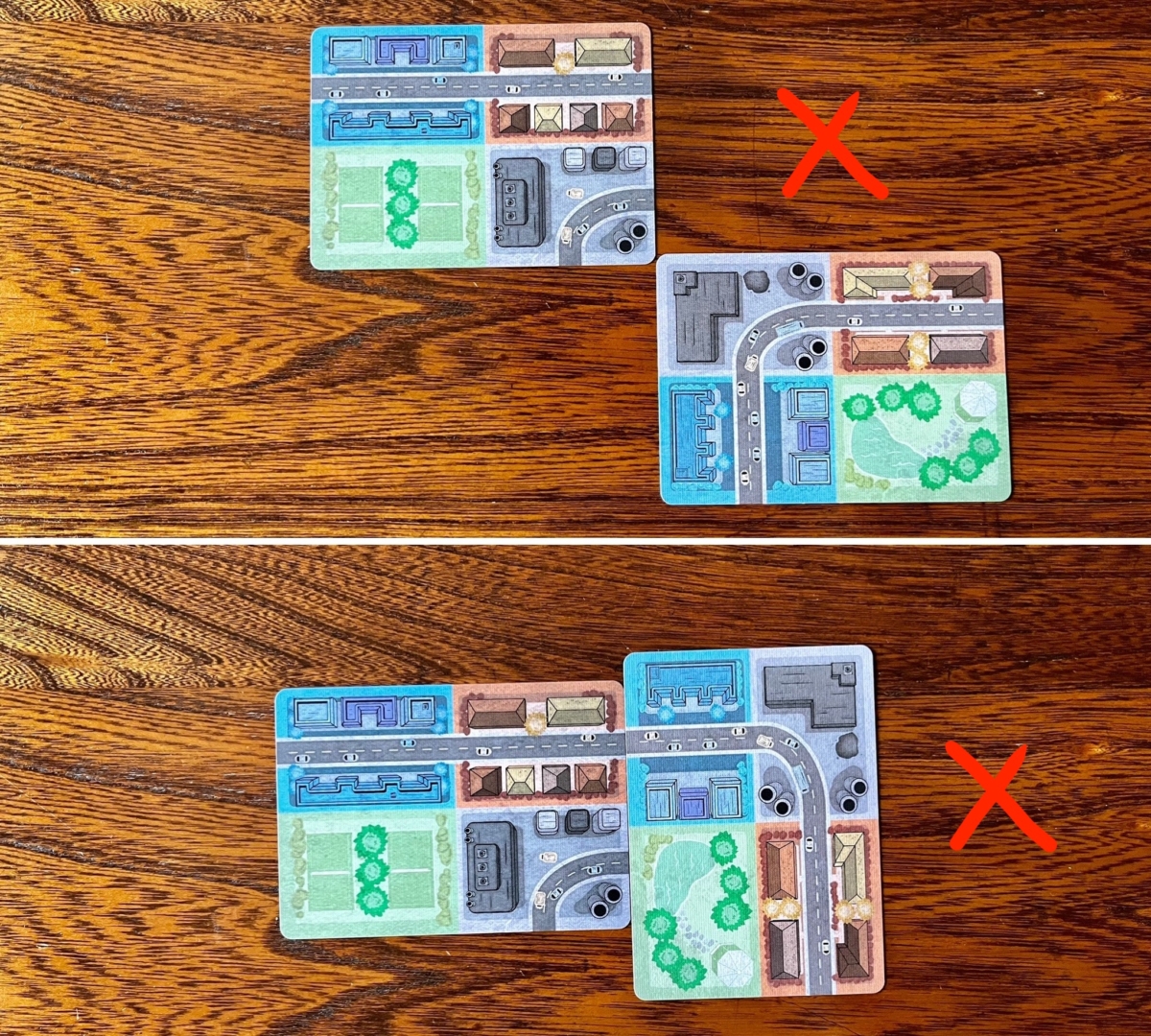
Cards cannot be played like this.
After you’ve played a card to your city’s build area, draw the top card from the draw pile and add it to your hand.
Continue playing 1 card and drawing a card to replenish your hand until all 15 cards have been added to your city. (Near the end of the game, the draw pile will be depleted while you still have cards in hand, so continue to play without drawing until you have none left.)
Game-end and Scoring
After all 15 cards have been played, tally your city’s score.
First, score 1 point per block in your largest group of each zone type. (A “group” is orthogonally adjacent blocks of the same zone type connected by an edge.)
This means you’ll score points for your largest park, industrial, residential, and commercial groups.
Then, subtract 1 point from your score for each road in your city.
Finally, score points according to the 3 Scoring Condition cards you laid out during setup.
If your score meets or exceeds the target score, you’ve won the game!
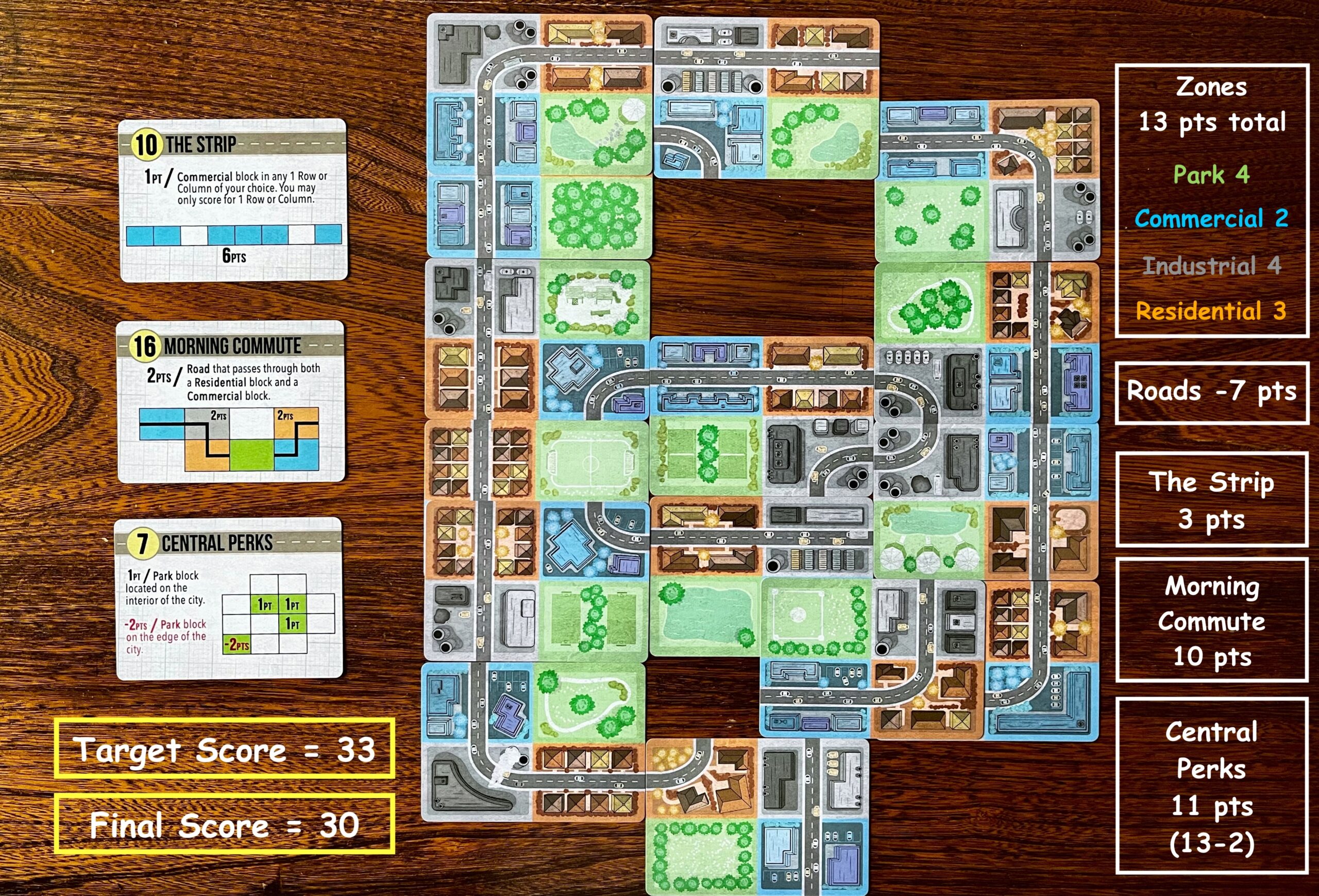
Unfortunately, this game resulted in a loss.
Multiplayer Changes
The basic gameplay rules and scoring are the same in a solo game as they are for multiplayer.
The main gameplay differences are that players cooperatively add cards to a shared build area and how they play those cards.
During setup, someone is chosen as the starting player. This person draws 3 Block cards to form their starting hand; the other players each draw 1 card.
Throughout the game, players must ensure that they keep the Block side of their cards hidden from other players — although they are allowed to discuss what’s on their cards.
On a turn, the starting player chooses 1 of the 3 cards in their hand to play to the city. Once they’ve revealed it to the other players, they’ve committed and must play it.
Players, however, may discuss how and where the card should be placed.
They then pass the other 2 cards remaining in their hand to the player to their left, who becomes the next starting player. Finally, they draw 1 card.
Everything else is the same for the multiplayer game as the solo: the placement rules, playing all 15 cards to the city, and scoring.
Sprawlopolis Review
Sprawlopolis is such a clever card game. For what is a simple concept with easy-to-learn rules, the decision-making in Sprawlopolis can be agonizing. In the most wonderful way, of course.
You will be tempted to break the placement rules and play cards vertically because of how perfectly a card could satisfy the Scoring Conditions.
You’ll curse the roads that always seem to curve in the wrong direction.
You’ll get annoyed with the cards that never seem to have the configuration of zones that you need to meet your objectives.
The target score will taunt you as you get down to your last few cards and realize you aren’t even close to achieving it.
This is all part of the tension and joy of Sprawlopolis’ puzzle.
Solo vs. Multiplayer
Sprawlopolis works well as a multiplayer game, but as I mentioned at the outset, it is a fantastic solo experience.
The payoff is huge compared to the amount of time it takes to set up and play Sprawlopolis; you will make so many strategic game moves that you’ll give your brain a nice workout.
There are many cooperative multiplayer games — like Marvel United and Letter Jam— I would recommend playing over Sprawlopolis; for solo gamers, though, it’s at the top of my list.
Replayability and Cost
Rest assured if you’re worried about Sprawlopolis’ replayability, given that it’s a game with only 18 cards.
The random draw of 3 Scoring Conditions and the way they interact with each other mix up the game and your strategy every time.
Moreover, which Block cards come out and the order in which they come into play is always different, so I’ve never felt Sprawlopolis lacked variability.
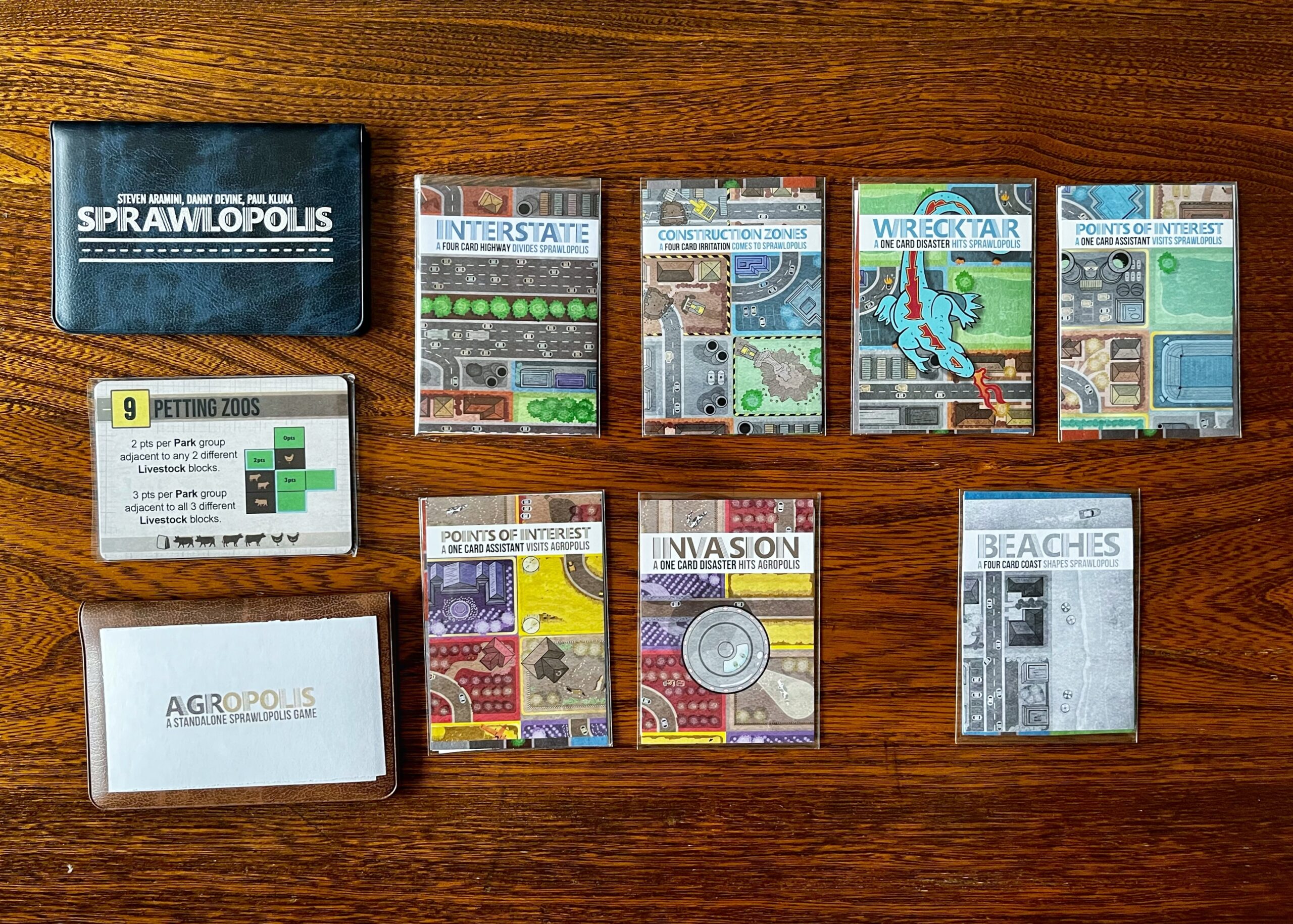
If you are still concerned, there are several mini expansions for Sprawlopolis and even a standalone farming version of the game, Agropolis.
I have heard people groan about the cost of the game (12 USD) for the components you get: only 18 cards and a plastic wallet.
For me, there is so much game in such a small package that Sprawlopolis is well worth the price.
Final Thoughts
Sprawlopolis may be a small, 18-card game, but it packs a real punch. It is a clever and challenging puzzle that feels different every game thanks to the unique Scoring Conditions. If you’re a solo gamer especially, don’t hesitate to check out Sprawlopolis.
You might also be interested in the following:


Uno Review - Skip, Skip, Pick Up Two
Monday 4th of December 2023
[…] Sprawlopolis Review […]
Village Green Review — Snobbish Shrubbery
Friday 3rd of February 2023
[…] that may be rather easy if not for the Green card placement rules that create a complex spatial puzzle as you try not to back yourself in a corner — something that often happens with new players […]